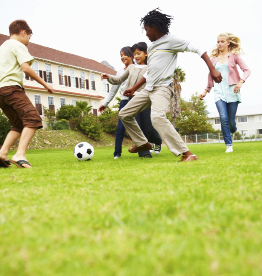Session 1
1. Session 1
1.5. Inquiry 3
Session 1: Physical Development
Inquiry 3: Promoting Physical Development Across the Seasons in Alberta
Winter
Children need to have opportunities to play outdoors throughout the year. The task of planning outdoor activities and moving outside to play during winter seems large for some child care providers. Playing outdoors in the winter requires many layers (mittens, scarves, boots, snowsuits, sweaters), and often the children have to go to the washroom as soon as they’re dressed up in all those layers!
Your own comfort level in the outdoors may also be a barrier to promoting outdoor activities. If you don’t enjoy or normally participate in outdoor activities, you may not have positive attitudes towards the outdoors to share with kids. Instead, you might communicate your own thoughts that you will all be cold and miserable outside.
The key to enjoyable outdoor activities is programming. Both children and adults lose track of time when they are having fun. Here are a few ideas for outdoor activities to do in the winter:
- Snow Painting: Fill squeeze bottles or spray bottles (e.g., shampoo or dish soap bottles) with warm, coloured water. Take children to an area of clean, fresh snow or to an area where snow has been ploughed up into a pile along a fence. A few drops of food colouring mixed with water are enough to paint lovely streaks and letters without staining clothes.
- Snow Block Building: A few weeks ahead, freeze water in containers of various shapes and sizes (e.g., milk cartons or yogurt containers). When you’ve collected a few dozen, remove the containers from the freezer, and then dip them into warm water. The blocks of ice will easily slide out of the containers. On a cold day, have the children use the ice blocks, alternating with frozen chunks of snow, to build walls, forts, houses, and so on.
- Snow Monster: This can be done as an alternative to snowmen or snowwomen in areas where the snow is too dry to pack easily. Simply shovel or push snow into a pile. Add twigs, rocks, paper-towel tubes, and other collage materials to give the monster a personality.
- Snow Box Play: Add pails, shovels, large cars, and trucks to a pile or box of snow.
- Winter Science: The properties of snow and ice can be fascinating to young children. Try the following activities, all of which work with either a little or a lot of snow:
– Cover a small piece of cardboard with black velvet or felt. Place the covered cardboard in the freezer until it is very cold. During a snowfall, bring the covered cardboard outside and let the children catch flakes on it. The children can then look at the flakes through a magnifying glass.
– Children can take a walk and look for tracks—boots, dogs, cats, ravens, rabbits, squirrels, and so on. Each child can make a special footprint, walk away, and then try and find the footprint again.
– Experiments: Melting and freezing can take place both inside and outside. Watch and listen to ice melt as salt is poured onto it. Bring snow to the water tables inside and have mittens available so children can sculpt the snow as it becomes icy.
- Winter Picnic: Any food that can be eaten easily by children wearing mittens will work well for your winter picnic. The usual fare of hot dogs is more of a novelty in winter if you are able to build a fire. A favourite drink is warm, cinnamon-flavoured apple juice.
Many games for preschoolers can be adapted to the outdoors all year round. Ball games, running games, parachute games, and obstacle courses lend themselves to play even when heavy clothing is worn and temperatures are freezing.

© Joshua Hodge Photography/iStockphoto
Rain
Rainy days can also offer fun activities. When the rain is falling, engage the children in the following finger play:
The rain is falling all around (fingers make rain falling)
Splish, splash, splish, splash (wiggle fingers)
Making puddles on the ground
Splish, splash, splish, splash (wiggle fingers)
The earthworms crawl about (hands and arms slither around)
Wiggle, waggle, wiggle, waggle
And disappear when the sun comes out
Zip, zip, zip zip (point thumbs down alternating between the left and the right thumb)
After a rainfall, take the children for a walk and collect earthworms from the sidewalks. Ask the children why the earthworms have come onto the sidewalks. After you are finished, return the worms to the dirt.
When outside on a rainy day, children need appropriate clothing, such as raincoats, rubber boots, and long pants.
Course Project
Have you added items and strategies to your strategies box for both indoor and outdoor play and for various seasons?